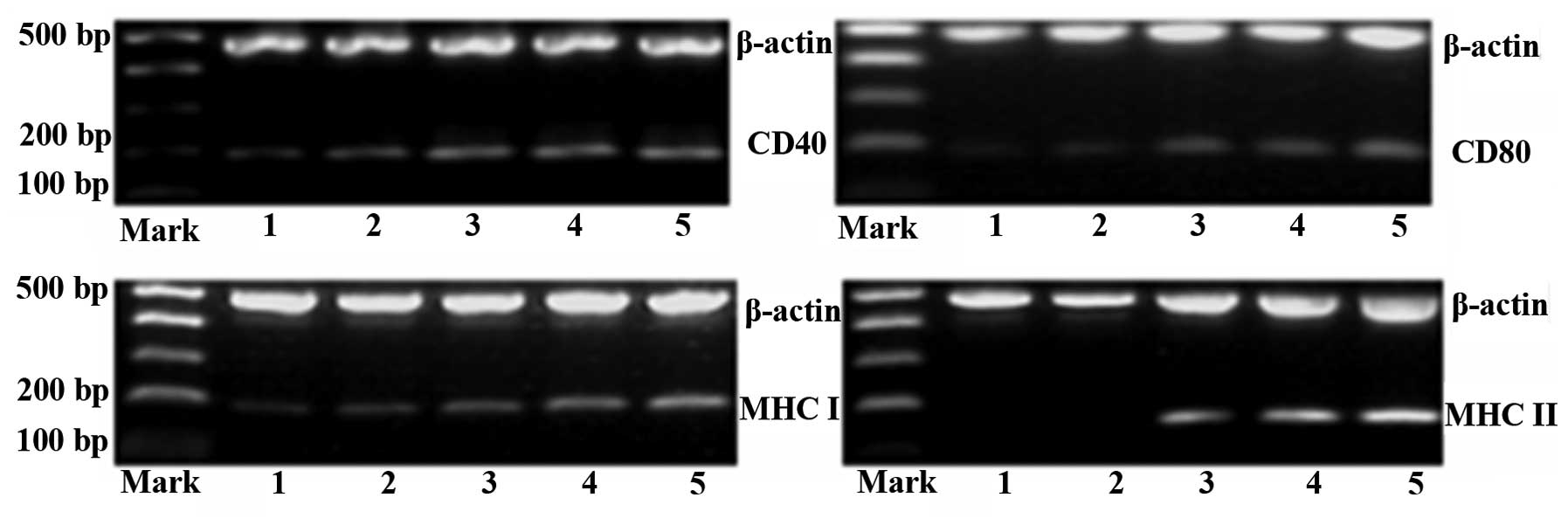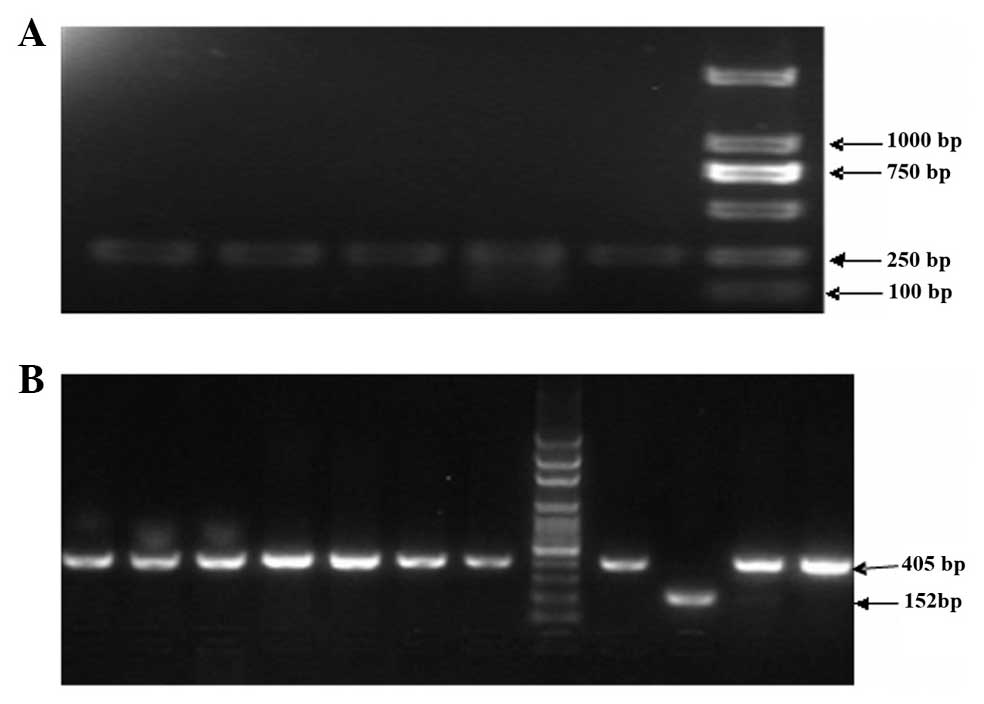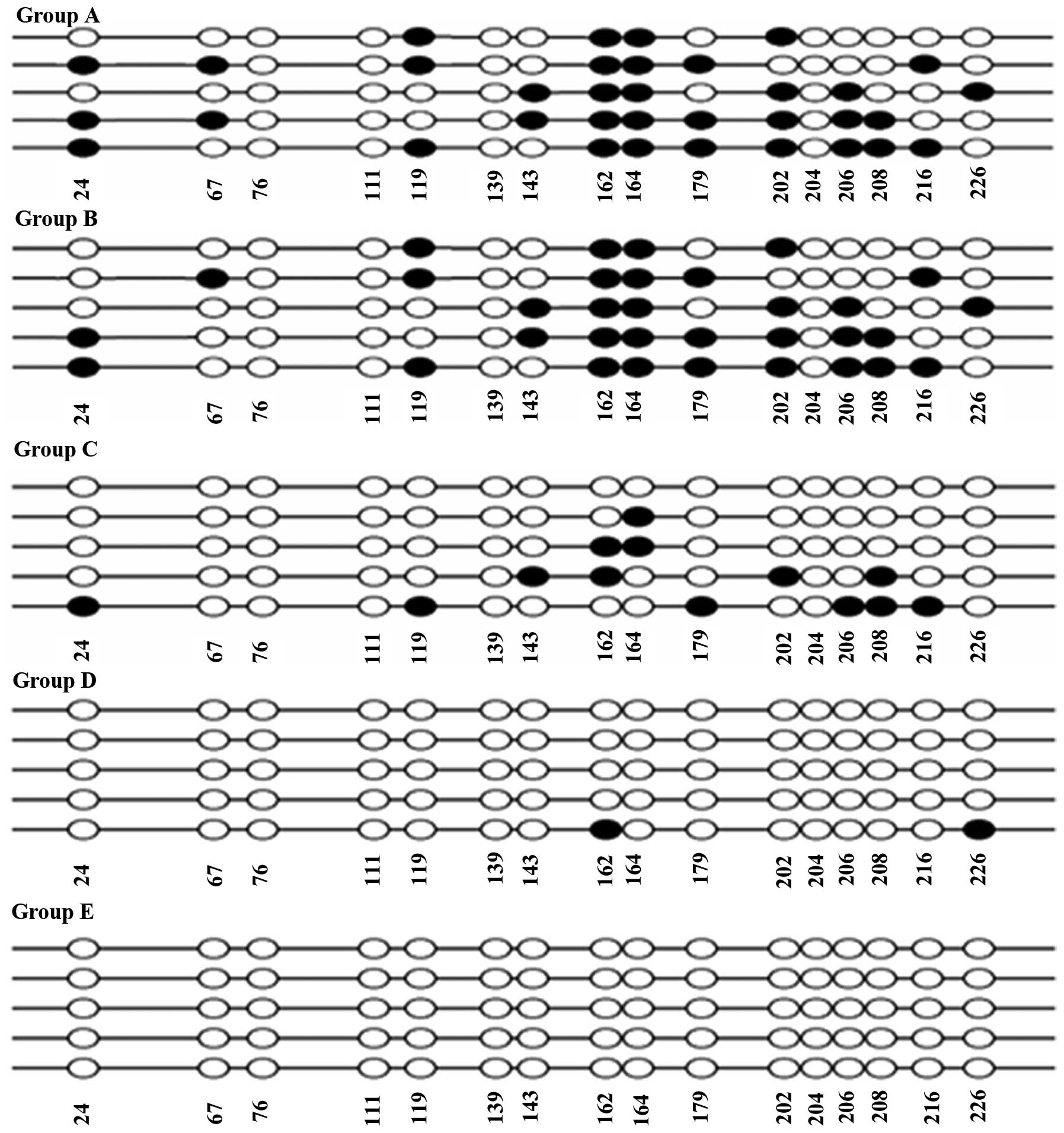|
1
|
McKenna SJ: Leukemia. Oral Surg Oral Med
Oral Pathol Oral Radiol Endod. 89:137–139. 2000. View Article : Google Scholar : PubMed/NCBI
|
|
2
|
Klippel ZK, Chou J, Towlerton AM, et al:
Immune escape from NY-ESO-1-specific T-cell therapy via loss of
heterozygosity in the MHC. Gene Ther. 21:337–342. 2014. View Article : Google Scholar : PubMed/NCBI
|
|
3
|
Siddle HV, Kreiss A, Tovar C, et al:
Reversible epigenetic down-regulation of MHC molecules by devil
facial tumour disease illustrates immune escape by a contagious
cancer. Proc Natl Acad Sci USA. 110:5103–5108. 2013. View Article : Google Scholar : PubMed/NCBI
|
|
4
|
Wolkersdörfer T, Fussel M, Kiesslich T, et
al: MHC class II genotype- and MHC class I and II phenotype-related
parameters in sporadic colorectal cancer. Oncol Rep. 26:1165–1171.
2011.PubMed/NCBI
|
|
5
|
Xu WC, Li ZB, Chen YR, et al: Expression
and distribution of S-100, CD83 and costimulatory molecules (CD80
and CD86) in tissues of thyroid papillary carcinoma. Cancer Invest.
29:286–292. 2011. View Article : Google Scholar : PubMed/NCBI
|
|
6
|
Fernando MM, Stevens CR, Walsh EC, et al:
Defining the role of the MHC in autoimmunity: A review and pooled
analysis. PLoS Genet. 4:e10000242008. View Article : Google Scholar : PubMed/NCBI
|
|
7
|
Choi NM, Majumder P and Boss JM:
Regulation of major histocompatibility complex class II genes. Curr
Opin Immunol. 23:81–87. 2011. View Article : Google Scholar :
|
|
8
|
Devaiah BN and Singer DS: CIITA and its
dual roles in MHC gene transcription. Front Immunol. 4:4762013.
View Article : Google Scholar
|
|
9
|
Otten LA, Steimle V, Bontron S and Mach B:
Quantitative control of MHC class II expression by the
transactivator CIITA. Eur J Immunol. 28:473–478. 1998. View Article : Google Scholar : PubMed/NCBI
|
|
10
|
Green MR, Yoon H and Boss JM: Epigenetic
regulation during B cell differentiation controls CIITA promoter
accessibility. J Immunol. 177:3865–3873. 2006. View Article : Google Scholar : PubMed/NCBI
|
|
11
|
Chen H, Gilbert CA, Hudson JA, Bolick SC,
Wright KL and Piskurich JF: Positive regulatory domain I-binding
factor 1 mediates repression of the MHC class II transactivator
(CIITA) type IV promoter. Mol Immunol. 44:1461–1470. 2007.
View Article : Google Scholar :
|
|
12
|
Pisapia L, Pozzo GD, Barba P, Citro A,
Harris PE and Maffei A: Contrasting effects of IFNalpha on MHC
class II expression in professional vs. nonprofessional APCs: Role
of CIITA type IV promoter. Results Immunol. 2:174–183. 2012.
View Article : Google Scholar
|
|
13
|
Baylin SB and Jones PA: A decade of
exploring the cancer epigenome-biological and translational
implications. Nat Rev Cancer. 11:726–734. 2011. View Article : Google Scholar : PubMed/NCBI
|
|
14
|
Sandoval J and Esteller M: Cancer
epigenomics: beyond genomics. Curr Opin Genet Dev. 22:50–55. 2012.
View Article : Google Scholar : PubMed/NCBI
|
|
15
|
Burke MJ and Bhatla T: Epigenetic
modifications in pediatric acute lymphoblastic leukemia. Front
Pediatr. 2:422014. View Article : Google Scholar : PubMed/NCBI
|
|
16
|
Chatterton Z, Burke D, Emslie KR, et al:
Validation of DNA methylation biomarkers for diagnosis of acute
lymphoblastic leukemia. Clin Chem. 60:995–1003. 2014. View Article : Google Scholar : PubMed/NCBI
|
|
17
|
Nordlund J, Backlin CL, Wahlberg P, et al:
Genome-wide signatures of differential DNA methylation in pediatric
acute lymphoblastic leukemia. Genome Biol. 14:r1052013. View Article : Google Scholar : PubMed/NCBI
|
|
18
|
Savickiene J, Treigyte G, Valiuliene G,
Stirblyte I and Navakauskiene R: Epigenetic and molecular
mechanisms underlying the antileukemic activity of the histone
deacetylase inhibitor belinostat in human acute promyelocytic
leukemia cells. Anticancer Drugs. 25:938–949. 2014. View Article : Google Scholar : PubMed/NCBI
|
|
19
|
Xu WS, Parmigiani RB and Marks PA: Histone
deacetylase inhibitors: molecular mechanisms of action. Oncogene.
26:5541–5552. 2007. View Article : Google Scholar : PubMed/NCBI
|
|
20
|
Londhe P, Zhu B, Abraham J, Keller C and
Davie J: CIITA is silenced by epigenetic mechanisms that prevent
the recruitment of transactivating factors in rhabdomyosarcoma
cells. Int J Cancer. 131:E437–E448. 2012. View Article : Google Scholar :
|
|
21
|
Cycon KA, Mulvaney K, Rimsza LM, Persky D
and Murphy SP: Histone deacetylase inhibitors activate CIITA and
MHC class II antigen expression in diffuse large B-cell lymphoma.
Immunology. 140:259–272. 2013. View Article : Google Scholar : PubMed/NCBI
|
|
22
|
Candiano G, Bruschi M, Musante L, et al:
Blue silver: A very sensitive colloidal Coomassie G-250 staining
for proteome analysis. Electrophoresis. 25:1327–1333. 2004.
View Article : Google Scholar : PubMed/NCBI
|
|
23
|
Dodd KW, Burns TC, Wiesner SM, et al:
Transgenic mice expressing luciferase under a 4.5 kb tyrosine
hydroxylase promoter. Cureus. 3:e342011.
|
|
24
|
Baev MV, Baev D, Radek AJ and Campbell JW:
Growth of Escherichia coli MG1655 on LB medium: Monitoring
utilization of sugars, alcohols, and organic acids with
transcriptional micro-arrays. Appl Microbilol Biot. 71:310–316.
2006. View Article : Google Scholar
|
|
25
|
Cohn M: How does the immune response get
started? Cell Immunol. 254:91–93. 2009. View Article : Google Scholar :
|
|
26
|
Weiss A, Imboden J, Hardy K, et al: The
role of the T3/antigen receptor complex in T-cell activation. Annu
Rev Immunol. 4:593–619. 1986. View Article : Google Scholar : PubMed/NCBI
|
|
27
|
Santos DO, Miranda A, Suffys P, et al:
Current understanding of the dendritic cells and their
co-stimulatory molecules as a key in generating efficient T cell
responses in lepromatous leprosy. Curr Immunol Rev. 3:77–85. 2007.
View Article : Google Scholar
|
|
28
|
Shafer-Weaver K, Anderson M, Malyguine A
and Hurwitz AA: T cell tolerance to tumors and cancer
immunotherapy. Adv Exp Med Biol. 601. pp. 357–368. 2007
|
|
29
|
Ueki T, Murata S, Kitamura N, Mekata E and
Tani T: Pre-treatment with cyclophosphamide or OX40 (CD134)
costimulation targeting regulatory T cell function enhances the
anti-tumor immune effect of adoptively transferred CD8+ T cells
from wild-type mice. Mol Med Rep. 2:615–620. 2009.PubMed/NCBI
|
|
30
|
Hung K, Hayashi R, Lafond-Walker A, et al:
The central role of CD4(+) T cells in the antitumor immune
response. J Exp Med. 188:2357–2368. 1998. View Article : Google Scholar : PubMed/NCBI
|
|
31
|
Magner WJ, Kazim AL, Stewart C, et al:
Activation of MHC class I, II and CD40 gene expression by histone
deacetylase inhibitors. J Immunol. 165:7017–7024. 2000. View Article : Google Scholar : PubMed/NCBI
|
|
32
|
Garrido C, Paco L, Romero I, et al: MHC
class I molecules act as tumor suppressor genes regulating the cell
cycle gene expression, invasion and intrinsic tumorigenicity of
melanoma cells. Carcinogenesis. 33:687–693. 2012. View Article : Google Scholar : PubMed/NCBI
|
|
33
|
Seliger B: The link between MHC class I
abnormalities of tumors, oncogenes, tumor suppressor genes and
transcription factors. J Immunotoxicol. 11:308–310. 2014.
View Article : Google Scholar : PubMed/NCBI
|
|
34
|
Daurkin I, Eruslanov E, Vieweg J and
Kusmartsev S: Generation of antigen-presenting cells from
tumor-infiltrated CD11b myeloid cells with DNA demethylating agent
5-aza-2′-deoxycytidine. Cancer Immunol Immunother. 59:697–706.
2010. View Article : Google Scholar
|
|
35
|
Sigalotti L, Coral S, Fratta E, et al:
Epigenetic modulation of solid tumors as a novel approach for
cancer immunotherapy. Semin Oncol. 32:473–478. 2005. View Article : Google Scholar : PubMed/NCBI
|
|
36
|
Reith W, Muhlethaler-Mottet A, Masternak
K, Villard J and Mach B: The molecular basis of MHC class II
deficiency and transcriptional control of MHC class II gene
expression. Microbes Infect. 1:839–846. 1999. View Article : Google Scholar : PubMed/NCBI
|
|
37
|
Ulbricht T, Alzrigat M, Horch A, et al:
PMl promotes MHC class II gene expression by stabilizing the class
II transactivator. J Cell Biol. 199:49–63. 2012. View Article : Google Scholar : PubMed/NCBI
|
|
38
|
Truax AD, Thakkar M and Greer SF:
Dysregulated recruitment of the histone methyltransferase EZH2 to
the class II transactivator (CIITA) promoter IV in breast cancer
cells. PLoS One. 7:e360132012. View Article : Google Scholar : PubMed/NCBI
|
|
39
|
De Lerma Barbaro A, De Ambrosis A, Banelli
B, et al: Methylation of CIITA promoter IV causes loss of HLA-II
inducibility by IFN-gamma in promyelocytic cells. Int Immunol.
20:1457–1466. 2008. View Article : Google Scholar : PubMed/NCBI
|
|
40
|
Radosevich M, Song Z, Gorga JC, Ksander B
and Ono SJ: Epigenetic silencing of the CIITA gene and
posttranscriptional regulation of class II MHC genes in ocular
melanoma cells. Invest Ophthalmol Vis Sci. 45:3185–3195. 2004.
View Article : Google Scholar : PubMed/NCBI
|
|
41
|
Holtz R, Choi JC, Petroff MG, Piskurich JF
and Murphy SP: Class II transactivator (CIITA) promoter methylation
does not correlate with silencing of CIITA transcription in
trophoblasts. Biol Reprod. 69:915–924. 2003. View Article : Google Scholar : PubMed/NCBI
|
|
42
|
Cameron EE, Bachman KE, Myohanen S, Herman
JG and Baylin SB: Synergy of demethylation and histone deacetylase
inhibition in the re-expression of genes silenced in cancer. Nat
Genet. 21:103–107. 1999. View
Article : Google Scholar : PubMed/NCBI
|
|
43
|
Shaker S, Bernstein M, Momparler LF and
Momparler RL: Preclinical evaluation of antineoplastic activity of
inhibitors of DNA methylation (5-aza-2′-deoxycytidine) and histone
deacetylation (trichostatin A, depsipeptide) in combination against
myeloid leukemic cells. Leuk Res. 27. pp. 437–444. 2003, View Article : Google Scholar
|














